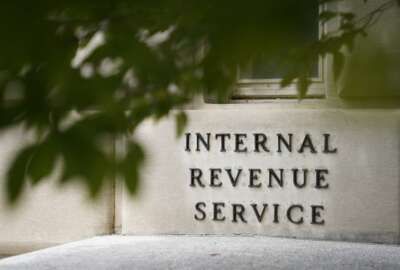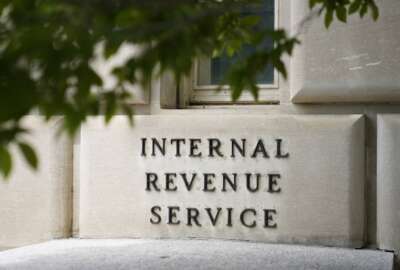Senators press for barcodes on tax returns so IRS can process them faster
Members of the Senate Finance Committee are calling on the Internal Revenue Service to rely on barcodes to process millions of paper tax returns more quickly.
Members of the Senate Finance Committee are calling on the Internal Revenue Service to rely on barcodes to process millions of paper tax returns more quickly.
The Barcode Automation for Revenue Collection to Organize Disbursement and Enhance (BARCODE) Efficiency Act, introduced by Sens. Tom Carper (D-Del.) and Todd Young (R-Ind.) on Thursday, would require all returns prepared electronically and filed on paper to include a scannable 2-D barcode.
Some taxpayers prepare their tax returns electronically, but choose to print them out and mail them to the IRS, rather than submit them online. That creates more work for IRS employees, and leads to delayed refunds.
Carper and Young said these barcodes would allow the IRS to easily digitize paper tax returns, and process them more quickly — leading to faster tax refunds.
“As government officials, we have a responsibility to be good stewards of taxpayer dollars. That includes ensuring that tax returns are processed accurately and promptly,” Carper said in a statement.
The Government Accountability Office, the National Taxpayer Advocate and lawmakers have all urged the IRS recently to adopt barcodes and other digitization tools to deal with a massive pandemic-era backlog of unprocessed paper tax returns.
While the IRS has mostly cleared its backlog of paper individual tax returns, the agency still faces challenges with some of its paper-based workload.
The National Taxpayer Advocate told Congress earlier this month that the IRS is still dealing with higher-than-average backlogs of taxpayer correspondence and amended tax returns.
“Millions of Americans are forced to wait months — and sometimes years — for the IRS to process their tax returns,” Young said. “Our bipartisan bill will better serve taxpayers by improving the processing of paper returns, reducing errors, and requiring the IRS to operate more efficiently.”
Lawmakers are calling on the IRS to tap into Inflation Reduction Act funds to implement 2-D barcodes and digitization technology.
The IRS is already tapping into those modernization funds to digitally process all the tax returns it receives by 2025 — a major shift for an agency that still relies heavily on paper forms.
The IRS expects its paperless processing initiative will eliminate up to 200 million pieces of paper annually, cut processing times in half, and expedite refunds by several weeks.
A congressional staffer said the BARCODE Efficiency Act will complement those efforts.
“There’s a lot of work being done by the IRS now to not just modernize, but also to improve customer service. So, it’s definitely complimentary to some of the work they’re already doing, in addition to efforts that Sen. Carper has championed to enhance customer experience,” the staffer said.
State tax agencies have used 2-D barcodes for more than two decades, and have improved the processing of tax returns.
The BARCODE Efficiency Act would also require the IRS to adopt optical character recognition (OCR) or similar technologies to accelerate its processing of paper returns.
The congressional staffer told Federal News Network that the bill would benefit the IRS and taxpayers by requiring the agency to use proven technology to minimize processing errors and delays. The staffer said it would also lead to faster tax refunds.
“Oftentimes, folks who file via paper returns have to wait a long time before they see their refunds, just because of the slow processing of these paper returns. This is going to exponentially make a difference, for both the taxpayer and for the IRS,” the staffer said.
The vast majority of taxpayers file their taxes electronically, but the IRS last year still received about 76 million paper tax returns and forms, and 125 million pieces of correspondence, notice responses, and non-tax forms.
It takes IRS employees much longer to manually process the paper tax returns the agency still receives.
IRS Commissioner Danny Werfel told reporters in August 2022 that up until now, IRS employees have had to manually input numbers by hand to process paper tax returns.
“This is very time-consuming and costly when compared with electronically filed returns,” Werfel said.
Members of the Senate Finance Committee, in a May 2022 letter, urged the IRS to implement 2-D barcodes to reduce a massive pandemic-era backlog of unprocessed paper tax returns.
Committee members, in their letter, told the IRS that “there is an urgent need to address the problem now.”
“If we were to wait for the promise of better technology, nothing would ever get implemented. To the contrary, the fact the 2-D technology is a bit older probably means it has been tested and is less expensive,” lawmakers wrote. “Many states currently use 2-D barcoding for tax returns, so we have proof it works.”
The congressional staffer said the BARCODE Efficiency Act would help the IRS prevent or minimize future backlogs.
“This is also going to help clear those backlogs in the future. Anything we can do to minimize that moving forward is helpful to make their practices more efficient,” the staffer said.
National Taxpayer Advocate Erin Collins recommended in 2022 that the IRS work with tax preparers to use a 2-D barcode on paper tax returns.
Collins said state tax agencies have been using scanning technology for years to automate the processing of paper tax returns.
But former IRS Commissioner Chuck Rettig told lawmakers in May 2022 that the IRS is looking beyond 2-D barcodes. He said the IRS asked for funding to implement 2-D barcodes in 2013, but never received the funding from Congress.
“If we were asking for it in 2013, we are 10 years essentially, technology-wise, beyond that,” Rettig said.
Rettig said scanning and digitization technology would help the agency reduce its backlog and improve efficiency, but probably wouldn’t result in workforce cost savings.
“There is not a perfect system that the IRS can buy today without a significant cost, both in terms of human cost and resources to get us where we need to be. But we are definitely going in that direction,” he said.
Copyright © 2024 Federal News Network. All rights reserved. This website is not intended for users located within the European Economic Area.
Jory Heckman is a reporter at Federal News Network covering U.S. Postal Service, IRS, big data and technology issues.
Follow @jheckmanWFED






